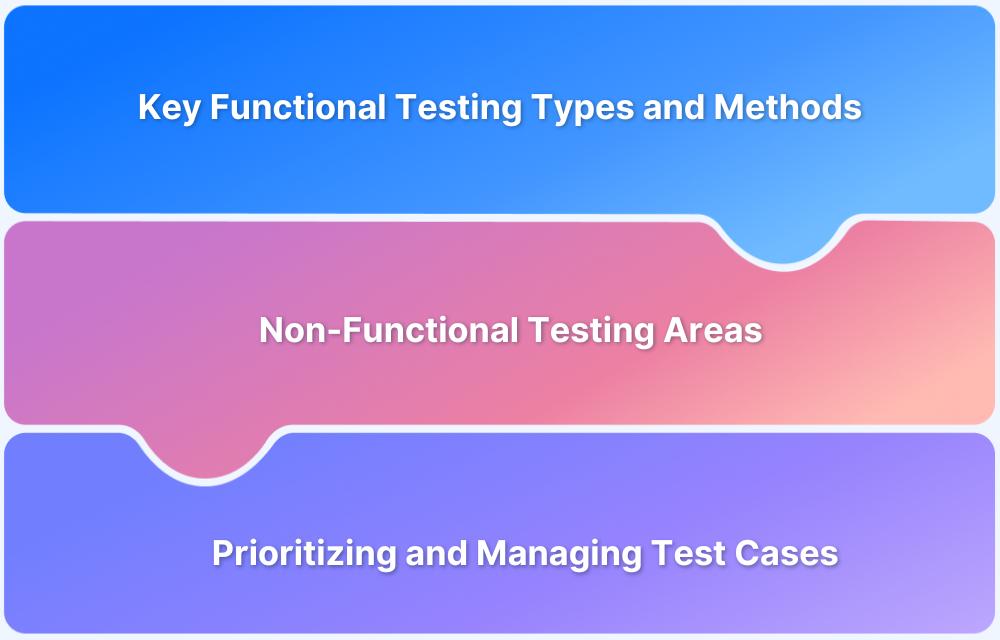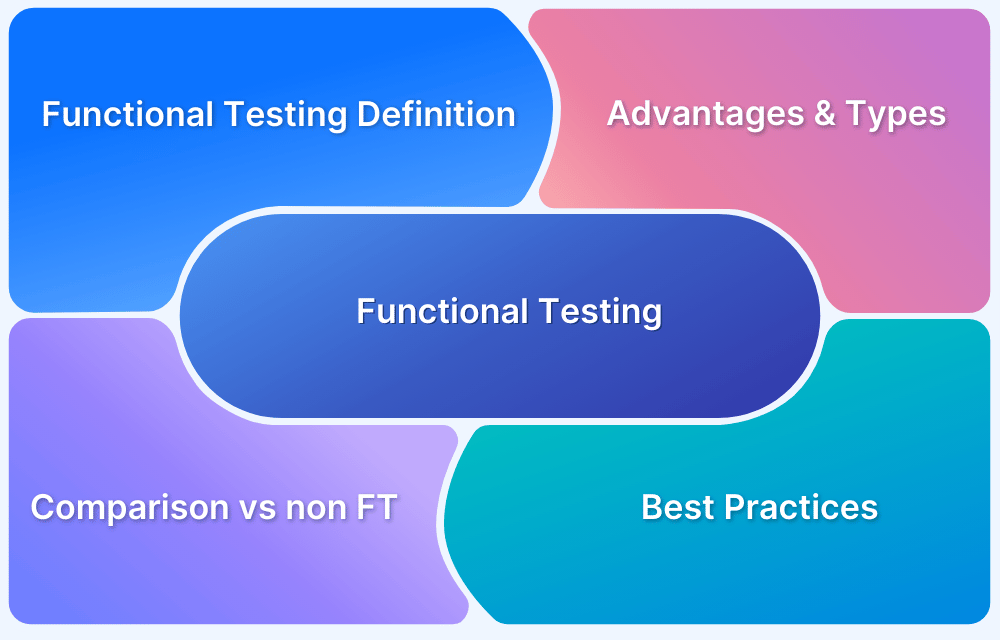Functional Testing ensures the application works as a whole, whereas Unit Testing focuses on verifying individual components or functions.
Overview
What is Functional Testing?
Functional Testing is a type of testing that verifies the functionality of the application against the defined requirements.
What is Unit Testing?
Unit Testing is a method used to test individual components or units of code in isolation.
Functional Testing vs. Unit Testing
- Purpose: Functional Testing checks if the entire system works as intended, while Unit Testing ensures individual code components function correctly.
- Scope: Functional Testing evaluates entire workflows and features, whereas Unit Testing isolates and tests specific functions or code segments.
- Level: Functional Testing is a higher-level test and evaluates the system as a whole. On the other hand, Unit Testing is low-level as it tests individual functions or methods.
- Technique: Functional Testing is a black-box technique that doesn’t require access to the source code, while Unit Testing is a white-box technique that does.
- Example: Testing the overall working of a Bluetooth speaker is functional testing, whereas, testing the Bluetooth indicator light is considered unit testing.
The guide explains what functional and unit testing are and how they differ from each other with examples.
Functional Testing
Functional Testing tests the basic functionality of the application. It checks if the application runs as per the business requirements. You need to read and understand the operational requirements of an app before you begin writing the Functional test cases and testing the application.
It checks if the page transitions are smooth if the UI is flawless, if the application saves data when the user goes to the next screen and if the end-to-end functioning of the application is perfect. Functional Testing is only concerned about the ‘user perspective’. It checks for accessibility, usability, and good application experience. It is not concerned about the coding aspects of an application.
Types of Functional Testing:
- Unit Testing
- Sanity Testing
- Smoke Testing
- Utility Testing
- Integration Testing
- Regression Testing
How to create a functional test case?
- As a QA, for a functional test to happen, the first step is to go through the business requirement document and familiarize themselves with the application.
- Form a test plan for the functionality to be tested.
- Select the right tool for the required type of functional Testing.
- Compare the actual results to the expected results. It reveals if the test has passed or failed.
Functional Test Case Examples
To compare the difference between unit testing and functional testing, let’s check the order history of an e-commerce application.
Test Case 1: Log in to the application
Step 1: Use ‘Username’ and ‘Password’ to login.
Step 2: On successful login, the user should see the dashboard.
Step 3: The dashboard should display Products in the web page’s body. The ‘My Account’ button should be in the top right corner. Next to ‘My Account’, there should be a’ Logout’ button.
Test Case 2: Navigating to the ‘Order History Page’
Step 1: On clicking ‘My Account’, the user should see ‘Order History, ‘Shipping address’, and ‘Wish list’.
Step 2: On clicking ‘Order History’, the user should see the list of past orders and the order number and tracking details.
Test Case 3: Display of Order History
Step 1: On clicking the specific order, the user should see the order date, product details, amount paid and shipping address of the specific order.
Step 2: The user should be able to go back to the previous order history page
Step 3: The user should be able to see canceled orders too.
Test Case 4: Navigating out of Order History Page
Step 1: User should be able to go to ‘Home’ page by clicking the ‘Home’ button on the top of the page.
Step 2: The user should be able to log out by clicking on the ‘Logout’ button on the top right corner of the screen.
The above example of testing the ‘Order History’ functionality is a test case example. Similarly, the entire application’s functionality is tested in Functional Testing.
Read More: Test Cases for an ECommerce Website
Functional Testing can be manual or automated. A few popular Automation testing tools are Selenium and Cucumber.
Best Practices for Functional Testing
- It is prudent to document the test cases for easy tracking.
- Automate the Testing for faster and more effective results.
- Test cases should be reusable to save time.
- Always start with testing complex and high-risk functionalities first.
Get Started with Functional Testing
Unit Testing
Unit Testing is testing individual elements of an application. Each element, like a text box, button, and text display, is tested to check if it performs the expected actions. These individual elements are called ‘Units’ which gave rise to the term Unit Testing. It is run on even the smallest element in an app.
These elements are individually and independently tested for issues. It cannot be conducted on components that connect to an external entity. For example, Unit Tests cannot be undertaken on elements that connect to an external database, network, or file. These tests are conducted right from the beginning of the development phase.
How to create a Unit Test Case
- Unit test cases evaluate every element of the application.
- You must write a Test Case for every button click and text box input.
- For every page of an application, multiple Unit Test cases are written to check the functionalities of all the page elements.
- Unit test cases ensure that none of the elements is missed.
- Multiple unit testing frameworks are available, and it’s essential to choose a proper one per the developer’s programming language.
Unit Test Case Examples
Let us use the same example for Functional Testing to compare the difference between Unit tests vs functional tests. Below is the sample test case for logging in to the e-commerce application.
Since it is a Unit Test case, we can take the individual elements like the ‘Username’ and ‘Password’ text boxes and the ‘Submit’ button.
Test Case 1: Username Input Text box
Step 1: The user should be able to click on the ‘Username’ text box and see the cursor inside
Step 2: ‘Username’ text box should accept alphabets.
Step 3: ‘Username’ text box should accept numbers.
Step 4: ‘Username’ text box should have at least one alphabet
Step 5: ‘Username’ text box should have at least one number
Step 6: ‘Username’ text box should not accept special characters.
Step 7: ‘Username’ text length should not exceed 15 alphanumeric characters.
Test Case 2: Password Input Text box
Step 1: The user should be able to click on the ‘Password text box and see the cursor inside
Step 2: ‘Password’ text box should accept alphabets.
Step 3: ‘Password’ text box should accept numbers.
Step 4: ‘Password’ text box should have at least one alphabet
Step 5: ‘Password’ text box should have at least one number
Step 6: ‘Password’ text box should have at least one special character.
Step 7: ‘Password’ text length should be eight and above.
Test Case 3: Submit button
Step 1: The user should be able to click on the ‘Submit’ button,
Step 2: ‘Username’ text box should not be empty.
Step 3: ‘Password’ text box should not be empty.
Step 4: Validate the Username with the existing database.
Step 5: Validate Password with the existing database.
Step 6: If the Username and Password validation are successful, the user should be taken to the ‘Home’ page.
Step 7: If the Username and Password validation are unsuccessful, the error message ‘Invalid Credentials’ should be displayed.
Tools Used for Unit Testing
Automated tools like Selenium are popular tools that allow you to write test scripts in various programming languages like Java, Ruby, Python, C#, PHP, NodeJS, and Perl, among others.
It is essential to choose a framework that is compatible with the programming language used by the developer.
- Popular Java Frameworks that can easily integrate with Selenium are JUnit and TestNG.
- We have a few frameworks for Python, among which PyUnit or UnitTest and PyTest are widely used.
- Test:Unit is a commonly used framework for Ruby Applications.
- Javascript frameworks that integrate well with Selenium are JEST and Jasmine.
Best Practices for Unit Testing
- Unit Testing has to be done right from the beginning of development.
- It has to go hand-in-hand with development.
- It is always better to detect bugs early in development, and Unit Testing plays a significant role in doing so effectively.
- While writing the Unit Test Scripts, it is better to avoid logical conditions. It increases the risk of bugs. In case it is unavoidable, split it into separate tests.
- Avoid interdependencies and treat every element to be independent functionalities.
- Following proper naming conventions while writing Unit Test cases for reusability and maintenance is essential.
Functional Testing vs Unit Testing: Differences
Let’s get into a detailed comparison for the Functional Test vs Unit Test below:
| Functional Testing | Unit Testing |
| It tests the flow, usability, and accessibility of the application. | It tests the functionality of the individual components of the application. |
| Functional Testing has multiple types of Testing, like Unit Testing, System Testing, etc., under its belt. | Unit Testing is a part of Functional Testing. |
| Functional testing is slow and tests the overall functionality of the application. | Unit test is fast and specific to individual components. |
| Functional testing pinpoints a general issue without being specific | Unit testing points to a specific issue |
| Testing the overall working of a Bluetooth speaker is an example of functional testing. | Testing a Bluetooth speaker’s Bluetooth connecting indicator light is an example of Unit Testing. |
| Functional testing frameworks are used for overall functional Testing. | Frameworks are integrated into functional testing frameworks to conduct Unit Testing. |
Conclusion
For effective app testing, unit testing is done parallel to development to ensure the critical bugs are fixed immediately. It reduces the bugs to a great extent when the application is undergoing functional testing. The difference between Functional Testing and Unit Testing has been laid out in detail for you to choose from. Ensure to test on the BrowserStack infrastructure for accurate, reliable results.






